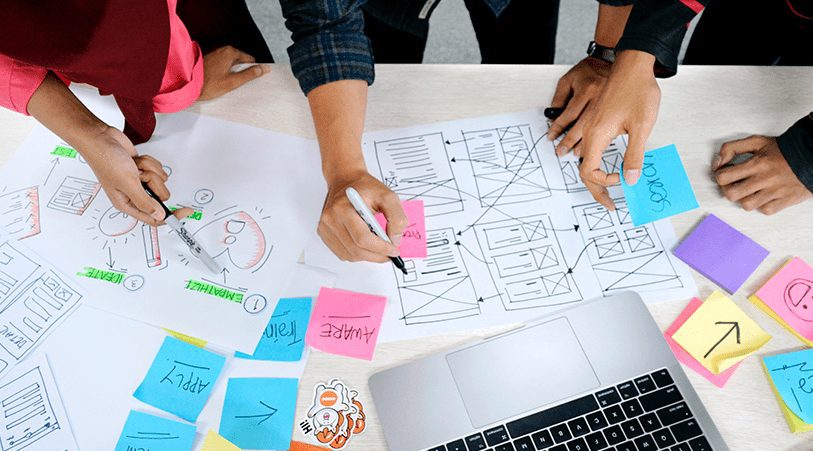Top 10 UI/UX Techniques by Web Designers
Creating an engaging and user-friendly website is crucial to creating the best online presence. Top web designers employ a range of UI/UX techniques to enhance the user experience and drive interaction. These strategies not only captivate visitors but also ensure smooth navigation and functionality. In this blog, we will explore the most underrated top 10 UI/UX techniques that web designers swear by. From intuitive layouts to compelling visuals, these methods will help you elevate your web design game, making your site more appealing and effective. Read this blog and discover how you can implement these powerful techniques into your website.
Intuitive navigation, responsive design, visuals, fast loading times, user-centered designs, and interactive elements were once used as the techniques. With the evolving technology it has become the mandatory feature of the website. In this blog, learn the top ten UI/UX techniques.
1. Predictive Search
Predictive search enhances user experience by anticipating and displaying search suggestions as users type. This feature helps users find what they are looking for quickly, reducing effort and increasing engagement. Predictive search is especially beneficial for e-commerce sites, where users may struggle to find specific items. By implementing this technique, a web design company in Coimbatore can improve user satisfaction and reduce bounce rates, leading to better overall site performance. The best web design services utilize predictive search to create a seamless, intuitive browsing experience that keeps users coming back.
2. Skeleton Screens
Skeleton screens are a UI/UX technique used to improve noticed load times by displaying a placeholder layout while content is loading. Instead of showing a blank screen or a loading spinner, users see a “skeleton” of the page that fills in as content loads. This technique reduces perceived wait time and keeps users engaged, preventing them from leaving the site. A web design company in Coimbatore can use skeleton screens to ensure that visitors have a smooth and uninterrupted browsing experience.
3. Content Chunking
Content chunking involves breaking down information into smaller, manageable segments to improve readability and user comprehension. This technique is particularly useful for web design companies in Coimbatore creating content-heavy sites. By organizing information into chunks, users can easily skim and digest content without feeling heavy. This enhances user experience, encourages longer site visits, and improves information retention. The best web design services employ content chunking to create well-structured websites that cater to users’ reading habits and preferences.
4. Contextual Help
Contextual help provides users with relevant assistance exactly when and where they need it. This can include tooltips, help icons, or inline assistance that guides users through complex processes or unfamiliar features. By offering immediate support, a web design company in Coimbatore can reduce user frustration and increase task completion rates.
5. Progressive Disclosure
Progressive disclosure is a design technique that involves revealing information gradually to prevent users from feeling clogged. By initially displaying only essential information and progressively disclosing more details as needed, users can navigate complex systems more easily. A web design company in Coimbatore can use this technique to create clean, user-friendly interfaces that reduce cognitive load and improve usability. The best web design services compulsorily implement progressive disclosure to enhance user experience, ensuring users can access information efficiently and intuitively.
6. Touch-Friendly Targets
Touch-friendly targets are UI elements designed to be easily tappable on touch devices. This involves ensuring buttons, links, and other interactive elements are large enough and spaced adequately to prevent accidental taps. For a web design company in Coimbatore, optimizing for touch interactions is crucial in the mobile-first era.
7. Emotional Design
Emotional design aims to create an emotional connection between the user and the product by using aesthetics, storytelling, and interactive elements that evoke positive emotions. This technique can significantly enhance user engagement and loyalty. A web design company in Coimbatore can incorporate emotional design to make websites more memorable and enjoyable.
8. Anticipatory Design
Anticipatory design involves predicting user needs and providing solutions before the user has to ask for them. This proactive approach can significantly improve user experience by reducing effort and streamlining interactions. For instance, a web design company in Coimbatore might implement features that suggest content or autofill forms based on user behavior. Anticipatory designs create intuitive, user-centric websites that anticipate and fulfill user needs efficiently, enhancing overall satisfaction and engagement.
9. Loading Animations
Loading animations keep users engaged during page load times by providing visual feedback that something is happening. These animations can range from simple progress indicators to more complex and entertaining graphics. A web design company in Coimbatore can use loading animations to improve perceived load times and reduce bounce rates. loading animations maintain user interest and provide a smoother, more enjoyable browsing experience.
10. User Journey Mapping
User journey mapping involves creating a visual representation of the user’s interactions with a website, from initial contact to the final goal. This technique helps designers understand user needs, pain points, and behaviors, allowing for more user-centered design. A web design company in Coimbatore can use user journey mapping to optimize site navigation and functionality, ensuring a seamless user experience.
Implement these techniques to transform your website’s user experience. Contact us today to get started!
1. What is the most used tool for UI UX design?
The most used tool for UI/UX design is Figma.
2. What are the top 5 steps of the UI UX design process?
Research, ideation, design, prototyping, and testing.
3 . What is the best UI UX approach?
The best UI/UX approach is user-centric design.
4. What do UI UX designers use to design?
UI/UX designers use tools like Figma, Sketch, Adobe XD, and InVision to design.

